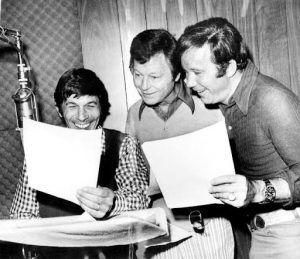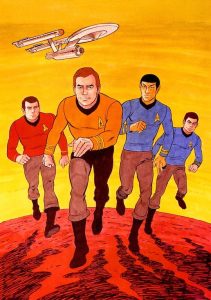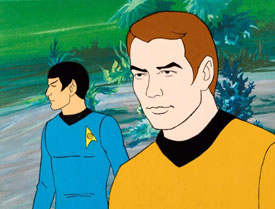
It’s hard to imagine a world without Star Trek. But, in June of 1969, that’s exactly what there was.

Leonard Nimoy, DeForrest Kelley and William Shatner record a scene for Filmation’s animated Star Trek
Then came syndication. At a time when reruns were part of our every day, Star Trek’s appreciation surged, creating one of the most devoted fan bases in history. In the 1970s, with interest in the show growing, the Filmation animation studio (who already had Saturday morning hits with The Archie Show and Fat Albert and the Cosby Kids) worked closely with Star Trek creator Gene Roddenberry, to bring Star Trek back to network television, in an animated form.
Filmation producer Lou Scheimer wanted to create an animated series of the show during Star Trek’s prime time run, but it never panned out. With reruns returning the series to the zeitgeist, there was no time better than the 70s.
Star Trek: The Animated Series (known simply as Star Trek in the show’s opening credits) debuted on NBC on September 8, 1973. For fans, much was immediately familiar about the series, including the opening narration, “Space, the final frontier…”
 Additionally, most of the cast from the original series returned to voice their animated counterparts: William Shatner as Captain Kirk, Leonard Nimoy as Mr. Spock, DeForest Kelley as Dr. “Bones” McCoy, Nichelle Nichols as communications officer Uhura, George Takei as Mr. Sulu and James Doohan as chief engineer “Scotty.”
Additionally, most of the cast from the original series returned to voice their animated counterparts: William Shatner as Captain Kirk, Leonard Nimoy as Mr. Spock, DeForest Kelley as Dr. “Bones” McCoy, Nichelle Nichols as communications officer Uhura, George Takei as Mr. Sulu and James Doohan as chief engineer “Scotty.”
There were also aspects of this new Star Trek that was fresh and exciting, as animation provided unlimited opportunities to bring the science fiction realm to life. In their book, Saturday Morning Fever: Growing Up with Cartoon Culture, authors Timothy Burke and Kevin Burke discussed this: “In the live-action Trek, makeup was both expensive and unconvincing, but animated Trek characters could be totally alien without costing anything extra. Two crew members were therefore added to the regular mix, Lieutenants Arex and M’ress. Arex was the more impressively imagined of the two, a wizened three-armed alien with bright red skin. M’ress was a feline alien, complete with long tail and mane.”
With Star Trek: The Animated Series, the Filmation studio was also able to realize worlds, settings, and even plots in animation that would have proven challenging (and costly) in live-action.
Additionally, several episodes of the Saturday morning series served as sequels of sorts to some live-action episodes (including the popular “The Trouble with Tribbles”). Star Trek: The Animated Series became a way to keep this engaging universe going and growing.
 As with many passionate fanbases, Star Trek: The Animated Series was, and is, divisive (some debate the show being part of the official Star Trek “canon”).
As with many passionate fanbases, Star Trek: The Animated Series was, and is, divisive (some debate the show being part of the official Star Trek “canon”).
Despite this, Star Trek: The Animated Series (which ran from 1973-1974) kept interest in the series going in a new way at a time before Star Trek feature films, innumerable TV shows, conventions, and almost every corner of pop culture was touched by the show.
Celebrating its fiftieth anniversary this year, Star Trek: The Animated Series can be seen as a creative and well-crafted way to realize the original show in a new medium, “boldly going” where Saturday morning television had never gone before.


 Michael Lyons is a freelance writer, specializing in film, television, and pop culture. He is the author of the book, Drawn to Greatness: Disney’s Animation Renaissance, which chronicles the amazing growth at the Disney animation studio in the 1990s. In addition to Animation Scoop and Cartoon Research, he has contributed to Remind Magazine, Cinefantastique, Animation World Network and Disney Magazine. He also writes a blog, Screen Saver: A Retro Review of TV Shows and Movies of Yesteryear and his interviews with a number of animation legends have been featured in several volumes of the books, Walt’s People. You can visit Michael’s web site Words From Lyons at:
Michael Lyons is a freelance writer, specializing in film, television, and pop culture. He is the author of the book, Drawn to Greatness: Disney’s Animation Renaissance, which chronicles the amazing growth at the Disney animation studio in the 1990s. In addition to Animation Scoop and Cartoon Research, he has contributed to Remind Magazine, Cinefantastique, Animation World Network and Disney Magazine. He also writes a blog, Screen Saver: A Retro Review of TV Shows and Movies of Yesteryear and his interviews with a number of animation legends have been featured in several volumes of the books, Walt’s People. You can visit Michael’s web site Words From Lyons at: 






















The sequel to “The Trouble with Tribbles” was one of two episodes written by David Gerrold, who wrote the original “The Trouble with Tribbles” as a 22-year-old student in 1966 and has been capitalising on it ever since. Filmation later engaged him to write the pilot for their Tarzan series, but he was taken off the project when the Edgar Rice Burroughs estate objected to changes he made in the story. As far as I know, Gerrold has not commented publicly on his experience with Filmation other than to say that getting fired was a blessing in disguise. He went on to develop “Land of the Lost” for Sid and Marty Krofft.
Star Trek TAS also showcased the versatile vocal talents of James Doohan, who in addition to his iconic role as Scotty also voiced the navigator Arex as well as most of the crewmen, aliens and other guest characters who appeared in the series. Doohan had been a very busy radio actor in his native Canada, but outside of this one show he did very little work in animation. Arex, incidentally, was always shown seated at his control console because creating a walk cycle for a three-armed, three-legged character would have severely taxed the skills of Filmation’s animators.
“creating a walk cycle for a three-armed, three-legged character would have severely taxed the skills of Filmation’s animators”
After all, what would credited animators on the show like Virgil Ross, Robert Bentley, Bob Carlson, Laverne Harding, Larry Silverman, or Reuben Timmins know about drawing creatures?
Budget reasons is most likely the answer.
I didn’t say they were bad animators. But years of experience animating Bugs Bunny and Woody Woodpecker wouldn’t have helped them devise a mode of tripedal locomotion that doesn’t exist in nature.
Even today no one wants to do that! If you watch any Edosian on Lower Decks you rarely see below the waist when the walk.
He talked on my podcast and commented in our book, Star Trek: The Official Guide to the Animated Series.
Like Filmation’s animated version of “Gilligan’s Island,” which came along at approximately the same time, there was very little action: the mouths did nearly all the movement while the bodies were mostly held cels. They got most of the original stars to voice their cartoon counterparts, but it pretty much stopped there. I don’t remember if the dialogue was even good.
Despite an already-large voice cast, they brought in Stanley Adams to reprise his role as the trader Cyrano Jones for the Tribble episode, Roger C. Carmel as Harcourt Fenton Mudd for that year’s Mudd episode, and Mark Lenard as Spock’s father, Sarek. (His mother, Amanda, was voiced by Majel Barrett, who also voiced M’Ress, and split most of the female guest roles with Nichelle Nichols.) Klingons Koloth and Kor returned, but voiced by Doohan.
Gerrold had a column in Starlog, where he mentioned being offered a job in the production of Filmation’s live-action Space Academy. He felt the show’s proposed format crossed that thin line between “youthful protagonists in exciting adventures” and “child endangerment,” but was told there was no time to rework it. That and other hints of lack of authority over what would have been his responsibility caused him to turn the job down. He instead wrote a Logan’s Run TV script for D.C. Fontana, who he had worked with on Star Trek live and animated.
This show single-handely raised the bar for children’s cartoon programming. It was intelligent, spoke elegantly, and engaged child, as well as adult, with thought-provoking plots.
Let’s not forget the richly orchestrated score by Ray Ellis. (Which was then added to that produced for Lassie and the Bradys for many shows to come). Made the Filmation experience very memorable, even with all the stuff people criticize the shows for.
Ellis composed the Filmation stock music, credited to his wife Yvette Blais (and to “Jeff Michael,” aka Norm Prescott).
Having seen cels from Filmation shows at conventions long ago, maybe their static output could be attributed with how they altered the cels. They would cut the registration pegs from the bottom and tape them to the top. They would also retape pegs to cels that would otherwise be pegless. Most of their budget seemed to go towards Scotch tape!
Of the 3 networks, NBC offered studios the lowest animation budgets. Filmation’s Gilligan’s Island cartoon (ABC) & My Favorite Martins (CBS) budgets were 100,000 per episode vs. the animated Star Trek budget which was going for around 75k. Both Gilligan & Martians had more fluid animation and few repeated stock scenes. However, Star Trek: TAS in spite of budget restrictions relied on strong storytelling which earned the Star Trek franchise its 1st Emmy Award! Also, technology and storylines from the animated series are referenced in Star Trek: Next Generation, Voyager & the theatrical Star Trek movies & novels.
YESTERYEAR about Spock as a kid and his pet who is dying and he has to make the decision of putting him down. Beautiful.
Its a rare a series of that era is still literate, touching and dignified.
This cartoon was super awesome STAS was on point and I believe you can watch full episodes on youtube.
I watched it when I was a kid – animation I remember well!
watched them when they first came out , have them on DVD now enjoy them with my great grandkids I’m a 67 year old kid at heart. I enjoy star trek in what ever form it takes. I love all sci-fi any shape or form
Another noteworthy episode was “The Slaver Weapon”, scripted by legendary sf writer Larry Niven, and based on his short story “The Soft Weapon” that was set in his “Known Space” series.